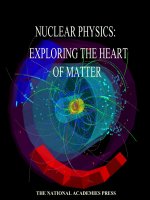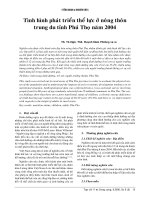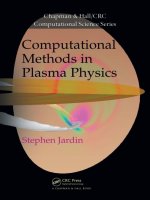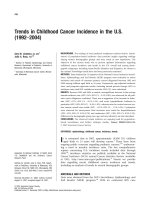2004 week2 physics
Bạn đang xem bản rút gọn của tài liệu. Xem và tải ngay bản đầy đủ của tài liệu tại đây (1.5 MB, 47 trang )
Basic Physical Principles
of MRI
James Voyvodic, Ph.D.
Brain Imaging and Analysis Center
Synopsis of MRI
1) Put subject in big magnetic field
2) Transmit radio waves into subject [2~10 ms]
3) Turn off radio wave transmitter
4) Receive radio waves re-transmitted by subject0
5) Convert measured RF data to image
Many factors contribute to MR
imaging
•
•
•
•
•
Quantum properties of nuclear spins
Radio frequency (RF) excitation properties
Tissue relaxation properties
Magnetic field strength and gradients
Timing of gradients, RF pulses, and signal
detection
MRI uses a combination of Magnetic
and Electromagnetic Fields
• NMR measures magnetization of atomic nuclei in the
presence of magnetic fields
• Magnetization can be manipulated by manipulating the
magnetic fields (this is how we get images)
• Static magnetic fields don’t change (< 0.1 ppm / hr):
The main field is static and (nearly) homogeneous
• RF (radio frequency) fields are electromagnetic fields that
oscillate at radio frequencies (tens of millions of times per
second)
• Gradient magnetic fields change gradually over space and can
change quickly over time (thousands of times per second)
Radio Frequency Fields
• RF electromagnetic fields are used to manipulate the
magnetization of specific types of atoms
• This is because some atomic nuclei are sensitive to
magnetic fields and their magnetic properties are tuned to
particular RF frequencies
• Externally applied RF waves can be transmitted into a
subject to perturb those nuclei
• Perturbed nuclei will generate RF signals at the same
frequency – these can be detected coming out of the
subject
Electromagnetic Radiation Energy
X-Ray, CT
MRI
What kinds of nuclei can be used
for NMR?
• Nucleus needs to have 2 properties:
– Spin
– charge
• Nuclei are made of protons and neutrons
– Both have spin ½
– Protons have charge
• Pairs of spins tend to cancel, so only atoms with
an odd number of protons or neutrons have spin
– Good MR nuclei are 1H, 13C, 19F, 23Na, 31P
Hydrogen atoms are best for MRI
• Biological tissues are predominantly 12C, 16O, 1H,
and 14N
• Hydrogen atom is the only major species that is
MR sensitive
• Hydrogen is the most abundant atom in the body
• The majority of hydrogen is in water (H2O)
• Essentially all MRI is hydrogen (proton) imaging
Nuclear Magnetic Resonance Visible Nuclei
Why do protons interact with a
magnetic field?
• Moving (spinning) charged particle
generates its own little magnetic field
• Spinning particles with mass have angular
momentum
A Single Proton
There is electric charge
on the surface of the
proton, thus creating a
small current loop and
generating magnetic
moment .
+
+
+
J
The proton also
has mass which
generates an
angular
momentum
J when it is
spinning.
Thus proton “magnet” differs from the magnetic bar in that it
also possesses angular momentum caused by spinning.
Magnetic Moment
B
B
I
L
L
F
F = IBL
Force
W
= IBLW =
IBA
Torque
max
sin
Angular Momentum
J = m=mvr
J
m
v
r
The magnetic moment and angular
momentum are vectors lying along the
spin axis
=J
is the gyromagnetic ratio
is a constant for a given nucleus
Vectors and Fields
•
Magnetic field B and magnetization M are vectors:
–
–
–
–
Quantities with direction as well as size
Drawn as arrows ....................................
Another example: velocity is a vector (speed is its size)
Vector operations:
dot product AB cos
cross product AB sin
• Magnetic field exerts torque to line magnets up in a
given direction
– direction of alignment is direction of B
– torque proportional to size of B [units=Tesla, Gauss=10–4 T]
How do protons interact with a
magnetic field?
• Moving (spinning) charged particle
generates its own little magnetic field
– Such particles will tend to line up with external
magnetic field lines (think of iron filings
around a magnet)
• Spinning particles with mass have angular
momentum
– Angular momentum resists attempts to change
the spin orientation (think of a gyroscope)
[Main magnet and some of its lines of force]
[Little magnets lining up with external lines of force]
Ref: www.simplyphysics.com
Net Magnetization
Bo
M
Bo
M c
T
Net magnetization
• Small B0 produces small net magnetization M
• Larger B0 produces larger net magnetization M,
lined up with B0
• Thermal motions try to randomize alignment of
proton magnets
• At room temperature, the population ratio of antiparallel versus parallel protons is roughly 100,000
to 100,006 per Tesla of B0
The Energy Difference Between
the Two Alignment States
E = 2 z Bo
Eh
/2
known as larmor frequency
/2= 42.57 MHz / Tesla for proton
Resonance frequencies of common nuclei
To measure magnetization we
must perturb it
• Need to apply energy to tip protons out of
alignment
– aligned with magnetic field is lowest energy
– aligned opposite magnetic field is next lowest
energy state
• Amount of energy needed depends on
nucleus and applied field strength (Larmor
frequency)
Basic Quantum Mechanics Theory of MR
The Effect of Irradiation to the Spin
System
Lower
Higher









